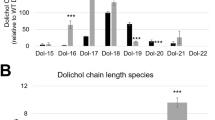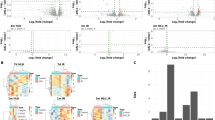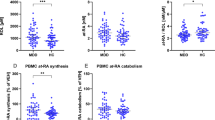Abstract
Retinoic acid, the active derivative of vitamin A (retinol), is a hormonal signaling molecule that acts in developing and adult tissues1. The Cyp26a1 (cytochrome p450, 26) protein metabolizes retinoic acid into more polar hydroxylated and oxidized derivatives2,3. Whether some of these derivatives are biologically active metabolites has been debated4,5. Cyp26a1−/− mouse fetuses have lethal morphogenetic phenotypes mimicking those generated by excess retinoic acid administration, indicating that human CYP26A1 may be essential in controlling retinoic acid levels during development6,7. This hypothesis suggests that the Cyp26a1−/− phenotype could be rescued under conditions in which embryonic retinoic acid levels are decreased. We show that Cyp26a1−/− mice are phenotypically rescued by heterozygous disruption of Aldh1a2 (also known as Raldh2), which encodes a retinaldehyde dehydrogenase responsible for the synthesis of retinoic acid during early embryonic development8,9. Aldh1a2 haploinsufficiency prevents the appearance of spina bifida and rescues the development of posterior structures (sacral/caudal vertebrae, hindgut, urogenital tract), while partly preventing cervical vertebral transformations and hindbrain pattern alterations in Cyp26a1−/− mice. Thus, some of these double-mutant mice can reach adulthood. This study is the first report of a mutation acting as a dominant suppressor of a lethal morphogenetic mutation in mammals. We provide genetic evidence that ALDH1A2 and CYP26A1 activities concurrently establish local embryonic retinoic acid levels that must be finely tuned to allow posterior organ development and to prevent spina bifida.
This is a preview of subscription content, access via your institution
Access options
Subscribe to this journal
Receive 12 print issues and online access
$259.00 per year
only $21.58 per issue
Buy this article
- Purchase on SpringerLink
- Instant access to full article PDF
Prices may be subject to local taxes which are calculated during checkout






Similar content being viewed by others
References
Livrea, M.A. Vitamin A and Retinoids: An Update of Biological Aspects and Clinical Applications (Birkhauser, Basel, 2000).
White, J.A. et al. Identification of the retinoic acid-inducible all-trans-retinoic acid 4-hydroxylase. J. Biol. Chem. 271, 29922–29927 (1996).
Fujii, H. et al. Metabolic inactivation of retinoic acid by a novel P450 differentially expressed in developing mouse embryos. EMBO J. 16, 4163–4173 (1997).
Pijnappel, W.W. et al. The retinoid ligand 4-oxo-retinoic acid is a highly active modulator of positional specification. Nature 366, 340–344 (1993).
Sonneveld, E., van den Brink, C.E., Tertoolen, L.G., van der Burg, B. & van der Saag, P.T. Retinoic acid hydroxylase (Cyp26a1) is a key enzyme in neuronal differentiation of embryonal carcinoma cells. Dev. Biol. 213, 390–404 (1999).
Abu-Abed, S. et al. The retinoic acid-metabolizing enzyme, CYP26A1, is essential for normal hindbrain patterning, vertebral identity, and development of posterior structures. Genes Dev. 15, 226–240 (2001).
Sakai, Y. et al. The retinoic acid-inactivating enzyme Cyp26a1 is essential for establishing an uneven distribution of retinoic acid along the anterior-posterior axis within the mouse embryo. Genes Dev. 15, 213–225 (2001).
Zhao, D. et al. Molecular identification of a major retinoic-acid-synthesizing enzyme, a retinaldehyde-specific dehydrogenase. Eur. J. Biochem. 240, 15–22 (1996).
Niederreither, K., Subbarayan, V., Dollé, P. & Chambon, P. Embryonic retinoic acid synthesis is essential for early mouse post-implantation development. Nature Genet. 21, 444–448 (1999).
Northrup, H. & Volcik, K.A. Spina bifida and other neural tube defects. Curr. Probl. Pediatr. 30, 313–332 (2000).
Valenzano, M. et al. Pathological features, antenatal ultrasonographic clues, and a review of current embryogenic theories. Hum. Reprod. Update 5, 82–86 (1999).
MacLean, G. et al. Cloning of a novel retinoic-acid metabolizing cytochrome P450, Cyp26B1, and comparative expression analysis with Cyp26a1 during early murine development. Mech. Dev. 107, 195–201 (2001).
Rossant, J., Zirnbigl, R., Cado, D., Shago, M. & Giguère, V. Expression of a retinoic acid response element-hsplacZ transgene defines specific domains of transcriptional activity during mouse embryogenesis. Genes Dev. 5, 1333–1344 (1991).
Hollemann, T., Chen, Y., Grunz, H. & Pieler, T. Regionalized metabolic activity establishes boundaries of retinoic acid signalling. EMBO J. 17, 7361–7372 (1998).
Niederreither, K., McCaffery, P., Dräger, U.C., Chambon, P. & Dollé, P. Restricted expression and retinoic acid-induced downregulation of the retinaldehyde type 2 (RALDH-2) gene during mouse development. Mech. Dev. 62, 67–78 (1997).
Swindell, E.C. et al. Complementary domains of retinoic acid production and degradation in the early chick embryo. Dev. Biol. 216, 282–296 (1999).
Achkar, C.C. et al. 4-oxoretinol, a new natural ligand and transactivator of the retinoic acid receptors. Proc. Natl Acad. Sci. USA 93, 4879–4884 (1996).
Lane, M.A., Chen, A.C., Roman, S.D., Derguini, F. & Gudas, L.J. Removal of LIF (leukemia inhibitory factor) results in increased vitamin A (retinol) metabolism to 4-oxoretinol in embryonic stem cells. Proc. Natl Acad. Sci. USA 96, 13524–13529 (1999).
Litingtung, Y. & Chiang, C. Specification of ventral neuron types is mediated by an antagonistic interaction between Shh and Gli3. Nature Neurosci. 3, 979–985 (2000).
Haines, N. & van den Heuvel, M. A directed mutagenesis screen in Drosophila melanogaster reveals new mutants that influence hedgehog signaling. Genetics 156, 1777–1785 (2000).
Dollé, P. et al. Disruption of the Hoxd-13 gene induces localized heterochrony leading to mice with neotenic limbs. Cell 75, 431–441 (1993).
Décimo, D., Georges-Labouesse, E. & Dollé, P. In situ hybridization to cellular RNA. in Gene Probes 2, A Practical Approach (eds Hames, B.D. & Higgins, S.J.) 182–210 (Oxford University Press, New York, 1995).
Acknowledgements
We thank J.M. Bornert and V. Fraulob for technical assistance. We are grateful to J. Rossant for providing the RARE-hsp-lacZ transgene. This work was supported by funds from the Centre National de la Recherche Scientifique, INSERM, the Collège de France, the Hôpitaux Universitaires de Strasbourg, the Association pour la Recherche sur le Cancer, the Fondation pour la Recherche Médicale and Bristol-Myers Squibb. S.A.A. holds a studentship from the Canadian Institutes of Health Research (CIHR), and M.P. is supported by the CIHR and the National Cancer Institute of Canada.
Author information
Authors and Affiliations
Corresponding author
Ethics declarations
Competing interests
The authors declare no competing financial interests.
Supplementary information
Rights and permissions
About this article
Cite this article
Niederreither, K., Abu-Abed, S., Schuhbaur, B. et al. Genetic evidence that oxidative derivatives of retinoic acid are not involved in retinoid signaling during mouse development. Nat Genet 31, 84–88 (2002). https://doi.org/10.1038/ng876
Received:
Accepted:
Published:
Issue date:
DOI: https://doi.org/10.1038/ng876
This article is cited by
-
Genetics and functions of the retinoic acid pathway, with special emphasis on the eye
Human Genomics (2019)
-
Scaling in vitro activity of CYP3A7 suggests human fetal livers do not clear retinoic acid entering from maternal circulation
Scientific Reports (2019)
-
Prenatal retinoic acid exposure reveals candidate genes for craniofacial disorders
Scientific Reports (2018)
-
Retinoic acid regulates avian lung branching through a molecular network
Cellular and Molecular Life Sciences (2017)
-
Signalling dynamics in vertebrate segmentation
Nature Reviews Molecular Cell Biology (2014)



